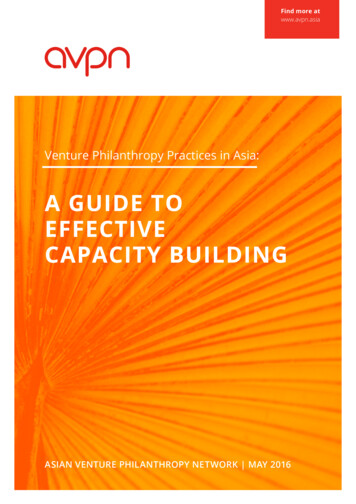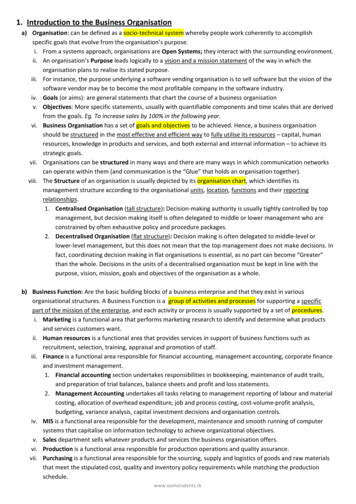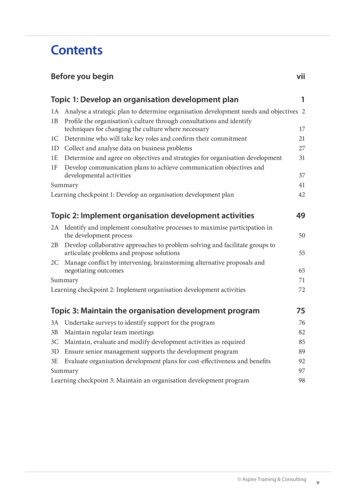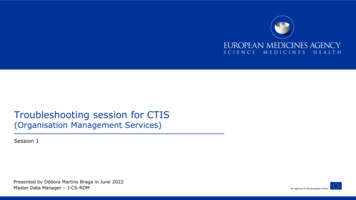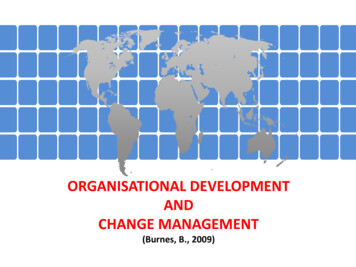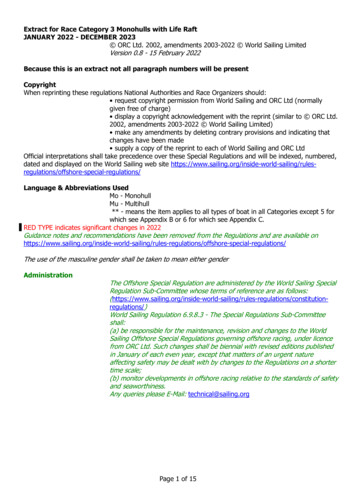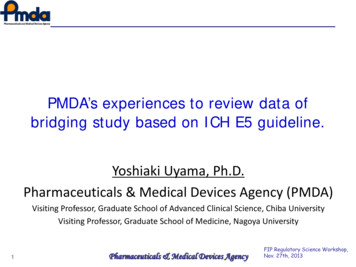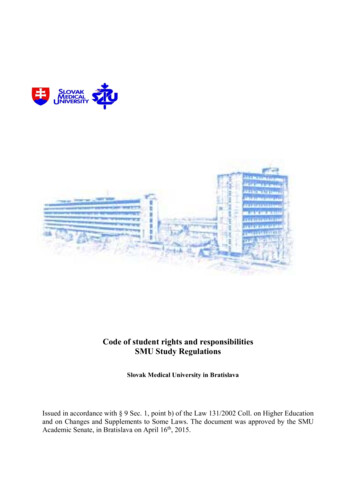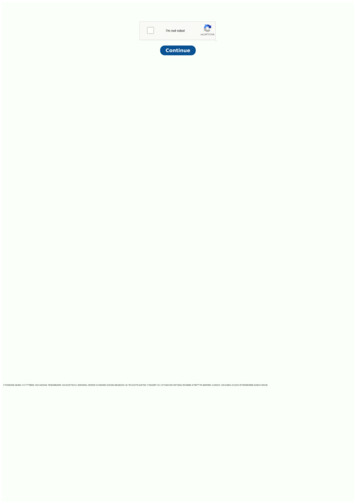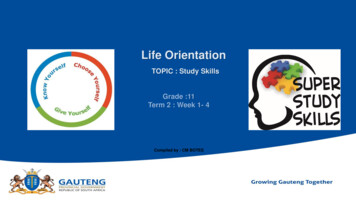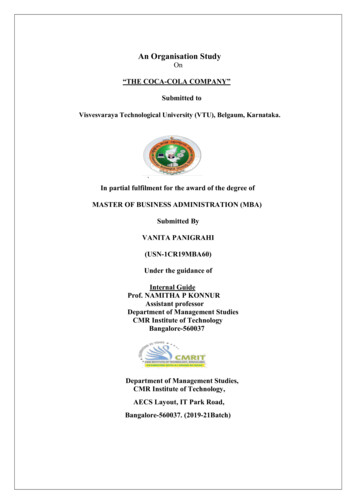
Transcription
An Organisation StudyOn“THE COCA-COLA COMPANY”Submitted toVisvesvaraya Technological University (VTU), Belgaum, Karnataka. In partial fulfilment for the award of the degree ofMASTER OF BUSINESS ADMINISTRATION (MBA)Submitted ByVANITA PANIGRAHI(USN-1CR19MBA60)Under the guidance ofInternal GuideProf. NAMITHA P KONNURAssistant professorDepartment of Management StudiesCMR Institute of TechnologyBangalore-560037Department of Management Studies,CMR Institute of Technology,AECS Layout, IT Park Road,Bangalore-560037. (2019-21Batch)
DECLARATIONI, Vanita Panigrahi hereby declare that the Internship report on “The Coca-Cola Company” is preparedby me under the guidance of Prof. NAMITHA P KONNUR, faculty of Department of ManagementStudies, CMR Institute of Technology.I also declare that this Internship work is towards the partial fulfillment of the university regulationsfor the award of degree of Master of Business Administration by Visvesvaraya TechnologicalUniversity, Belgaum.I have undergone an internship of organization study for a period of Four weeks. I further declare thatthis report is based on the original study undertaken by me and has not been submitted for the awardof any degree/diploma from any other University /Institution.Place: BangaloreSignature of the student
ACKNOWLEDGEMENTI wish to pledge and reward my deep sense of gratitude for all those who have made this InternshipReport come alive.I would like to express my heart-felt gratitude to thank Mr. Sanjay Jain, principal, CMR Institute ofTechnology, for his valuable suggestions and moral support throughout the course of my project.I would like to express my heart-felt gratitude to Mr. Sandeep Kumar N - HOD,Department of Management Studies CMR Institute of Technology for his valuable suggestions andmoral support throughout the course of my project.I am gratefully indebted to my internal faculty guide Prof. NAMITA P KONNUR, CMR Institute ofTechnology, for encouraging me and for her constant support throughout the course of the project andhelping me complete it successfully.Finally, I express my sincere thanks to my Parents, friends and all the staff of MBA department ofCMRIT for their valuable suggestions in completing this Internship Report.VANITA PANIGRAHI(1CR19MBA60)
TABLE OF CONTENTSChapterNo.Particular01INTRODUCTION TO COCA-COLA02INDUSTRY PROFILE03ORGANIZATION PROFILE04BACKGROUND05NATURE OF BUSINESS06VISION MISSION07QUALITY POLICY08WORKFLOW MODEL09PRODUCT PROFILE10OWNERSHIP PATTERN11ACHIEVEMENTS12FUTURE GROWTH AND PROSPECT13THE McKENSY’S 7S FRAMEWORKPORTER’S FIVE FORCES OF COCA-COLAPage No.
1415SWOT ANALYSIS16COCA-COLA FINANCIAL ANALYSIS17BIBLIOGRAPHY
EXECUTIVE SUMMARYThis report has been prepared with a specific purpose in mind. It outlines the history and currentscenario of the Coca-Cola Company globally and locally. The first part of the study takes us throughthe present state of affairs of the beverage industry and Coca-Cola Company globally.The report contains a brief introduction of Coca Cola Company and Coca-Cola India and a detailedview of the tasks, which have been undertaken to analyze the market of Coca-Cola i.e. we haveperformed Competitive, PESTLE and SWOT analysis of Coca-Cola Company and PESTLE andSWOT analysis of Coca-Cola India in order to identify areas of potential growth for Coca-Cola. Wehave also given a brief description of Trends and Forces that are affecting Coca-Cola Companyglobally.The main objective of this project report is to analyze and study in efficient way the current positionof Coca- Cola Company. The study also aims to perform Market Analysis of Coca-Cola Company &find out different factors effecting the growth of Coca-Cola. Another objective of the study was toperform Competitive analysis between Coca-Cola and its competitors. Apart from these objectives thisstudy is also conducted to understand the Customer preferences towards various Coca-Cola products.
INTRODUCTION TO COCA-COLA
INTRODUCTION TO COCA-COLACoca-Cola, the product that has given the world its best-known taste was born in Atlanta Georgia, onMay 8. 1886. Coca-Cola Company is the world's leading manufacturer marketer and distributor ofnon-alcoholic beverage concentrates and syrups, used to produce nearly 400 beverage brands. It sellsbeverage concentrates and syrups to bottling and canning operators, distributors, fountain retailers andfountain wholesalers. The Company's beverage products comprise of bottled and canned soft drinksas well as concentrates, syrups and not-ready-to-drink powder products. In addition to this, it alsoproduces and markets sports drinks, tea and coffee.The Coca-Cola Company began building its global network in the 1920s. Now operating in more than200 countries and producing nearly 400 brands the Coca-Cola system has successfully applied a simpleformula on a global scale: "Provide a moment of refreshment for a small amount of money- a billiontimes a day."The Coca-Cola Company and its network of bottlers comprise the most sophisticated and pervasiveproduction and distribution system in the world. More than anything, that system is dedicated to peopleworking long and hard to sell the products manufactured by the Company. This unique worldwidesystem has made The Coca-Cola Company the world’s premier soft-drink enterprise. From Boston toBeijing, from Montreal to Moscow, Coca-Cola more than any other consumer product, has broughtpleasure to thirsty consumers around the globe. For more than 115 years, Coca-Cola has created aspecial moment of pleasure for hundreds of millions of people every day.
The Company aims at increasing shareowner value over time. It accomplishes this by working with itsbusiness partners to deliver satisfaction and value to consumers through a worldwide system ofsuperior brands and services, thus increasing brand equity on a global basis. They aim at managingtheir business well with people who are strongly committed to the Company values and culture andproviding an appropriately controlled environment, to meet business goals and objectives. Theassociates of this Company jointly take responsibility to ensure compliance with the framework ofpolicies and protect the Company's assets and resources whilst limiting business risks.
INDUSTRY PROFILE
INDUSTRY PROFILEA BRIEF INSIGHT OF THE FMCG INDUSTRY IN INDIAFast Moving Consumer Goods (FMCG) also known as Consumer-Packaged Goods (CPG), areproducts that have a quick turnover and relatively low cost. Consumers generally put less thought intothe purchase of FMCG than they do for other products.The Indian FMCG industry witnessed significant changes through the 1990s. Many players had beenfacing severe problems on account of increased competition from small and regional players and fromslow growth across its various product categories. As a result, most of the companies were forced torevamp their product, marketing, distribution and customer service strategies to strengthen theirposition in the market.By the turn of the 20th century, the face of the Indian FMCG industry had changed significantly. Withthe liberalization and growth of the Indian economy, the Indian customer witnessed an increasingexposure to new domestic and foreign products through different media, such as television and theInternet.Apart from this, social changes such as increase in the number of nuclear families and the growingnumber of working couples resulting in increased spending power also contributed to the increase inthe Indian consumers’ personal consumption. The realization of the customer's growing awareness andthe need to meet changing requirements and preferences on account of changing lifestyles required theFMCG producing companies to formulate customer-centric strategies. These changes had a positiveimpact, leading to the rapid growth in the FMCG industry. Increased availability of retail space, rapidurbanization, and qualified manpower also boosted the growth of the organized retailing sector.HLL led the way in revolutionizing the product market, distribution and service formats of the FMCGindustry by focusing on rural markets, direct distribution, creating new product, distribution andservice formats. The FMCG sector also received a boost by government led initiatives in the 2003budget such as the setting up of excise free zones in various parts of the country that witnessed firmsmoving away from outsourcing to manufacturing by investing in the zones.
Though the absolute profit made on FMCG products is relatively small, they generally sell in largenumbers and so the cumulative profit on such products can be large. Unlike some industries, such asautomobiles, computers, and airlines, FMCG does not suffer from mass layoffs every time theeconomy starts to dip. A person may put off buying a car, but he will not put off having his dinner.Unlike the other economic sectors, FMCG share float in a steady manner irrespective of global marketdip, because they generally satisfy rather fundamentals as opposed to luxurious needs. The FMCGsector which is growing at the rate of 9% is the fourth largest sector in the Indian Economy and isworth Rs 93000 cr. The main contributor making up 32% of the sector is the South Indian region. It ispredicted that in the year 2021, the FMCG sector will be worth Rs.243000 cr. The sector being one ofthe biggest sectors of the Indian Economy provides up to 4 million jobs. (Source: HCCBPL, MonthlyCircular)
ORGANIZATION PROFILE
ORGANIZATION PROFILEThe Coca-Cola Company is the #1 nonalcoholic beverage companies in the world, as well as one ofthe world's most recognizable brands. It is home to more than 500 beverage brands, some 20 of thosebillion-dollar-brands, including four of the top five soft drinks: Coca-Cola, Diet Coke, Fanta, andSprite. In addition to soft drinks, it markets waters, juice drinks, energy and sports drinks, dairy andplant-based beverages, and ready-to-drink teas and coffees. Other top brands include Minute Maid,Powerade, Dasani, Honest Tea, and vitamin water. With the world's largest beverage distributionsystem, Coca-Cola reaches thirsty consumers in more than 200 countries. Nearly 65% of its sales comefrom outside the US.
BACKGROUND
BackgroundThe prototype Coca-Cola recipe was formulated at the Eagle Drug and Chemical Company, a Drugstore in Columbus, Georgia by John Pemberton, originally as a coca wine called Pemberton's FrenchWine Coca. He may have been inspired by the formidable success of Vin Mariani, a European cocawine.In 1886, when Atlanta and Fulton County passed prohibition legislation, Pemberton responded bydeveloping Coca-Cola essentially a non-alcoholic version of French Wine Coca. The first sales wereat Jacob's Pharmacy in Atlanta Georgia, on May 8, 1886. It was initially sold as a patent medicine forfive cents a glass at soda fountains which were popular in the United States at the time due to the beliefthat carbonated water was good for the health. (9 Pemberton claimed Coca-Cola cured many diseases,including morphine addiction, dyspepsia, neurasthenia, headache. and impotence Pemberton ran thefirst advertisement for the beverage on May 29 of the same year in the Atlanta Journal.By 1888 three versions of Coca-Cola - sold by three separate businesses - were on the market. AsaGriggs Candler acquired a stake in Pemberton's company in 1887 and incorporated it as the Coca ColaCompany in 1888. The same year, while suffering from an ongoing addiction to morphine, Pembertonsold the rights a second time to four more businessmen J.C. Mayfield, A.O. Murphey, C.O. Mullahyand E.H. Bloodworth. Meanwhile, Pemberton's alcoholic son Charley Pemberton began selling hisown version of the product.John Pemberton declared that the name "Coca-Cola" belonged to Charley, but the other twomanufacturers could continue to use the formula. So, in the summer of 1888, Candler sold his beverageunder the names Yum Yum and Koke. After both failed to catch on. Candler set out to establish a legalclaim to Coca-Cola in late 1888. in order to force his two competitors out of the business. Candlerpurchased exclusive rights to the formula from John Pemberton.Margaret Dozier and Woolfolk Walker however in 1914, Dozier came forward to claim her signatureon the bill of sale had been forged and subsequent analysis have indicated John Pemberton's signaturewas most likely a forgery as well.In 1892 Candler incorporated a second company, The Coca-Cola Company (the current corporation),and in 1910 Candler had the earliest records of the company burned, further obscuring its legal origins.
By the time of its 50th anniversary, the drink had reached the status of a national icon in the USA. In1935, it was certified kosher by Rabbi Tobias Geffen, after the company made minor changes in thesourcing of some ingredients.Coca-Cola was sold in bottles for the first time on March 12, 1894. The first outdoor wall theadvertisement was painted in the same year as well in Cartersville, Georgia. Cans of Coke firstappeared in the year 1955. The first bottling of Coca-Cola occurred in Vicksburg, Mississippi, at theBiedenharn Candy Company in 1891. Its proprietor was Joseph A. Biedenharn. The original bottleswere Biedenham bottles very different from the much later hobble-skirt design that is now so familiar.Asa Candler was tentative about bottling the drink, but two entrepreneurs from Chattanooga,Tennessee Benjamin F, Thomas and Joseph B. Whitehead proposed the idea and were so persuasivethat Candler signed a contract giving them control of the procedure for only one dollar. Candler nevercollected his dollar, but in 1899 Chattanooga became the site of the first Coca-Cola bottling company.The loosely termed the contract proved to be problematic for the company for decades to come. Legalmatters were not helped by the decision of the bottlers to subcontract to other companies, effectivelybecoming parent bottlers Coke concentrate or Coke syrup, was and is sold separately at pharmacies insmall quantities, as an over-the-counter remedy for nausea and mildly upset stomach.On April 23 1985, Coca-Cola, amid much publicity, attempted to change the formula of the drink with"New Coke" Follow-up taste tests revealed that most consumers preferred the taste of New Coke toboth Coke and Pepsi, but Coca-Cola management was unprepared for the public's nostalgia for the olddrink, leading to a backlash. The company gave in to protests and returned to a variation of the oldformula, under the name Coca-Cola Classic on July 10. 1985.On February 7 2005, the Coca-Cola Company announced that in the second quarter of 2005 theyplanned to launch a Diet Coke product sweetened with the artificial sweetener sucralose, the samesweetener currently used in Pepsi One. On March 21, 2005, it announced another diet product CocaCola Zero, sweetened partly with a blend of aspartame and acesulfame potassium. In 2007, Coca-Colabegan to sell a new "healthy soda": Diet Coke with vitamins B6, B12, magnesium, niacin, and zinc,marketed as "Diet Coke Plus". On July 5 2005, it was revealed that Coca-Cola would resumeoperations in Iraq for the first time since the Arab League boycotted the company in 1968.
In April 2007 in Canada the name "Coca-Cola Classic" was changed back to "Coca-Cola." The word"Classic" was truncated because "New Coke" was no longer in production, eliminating the need todifferentiate between the two. The formula remained unchanged.In January 2009 Coca-Cola stopped printing the word "Classic" on the labels of 16-ounce bottles soldin parts of the southeastern United States. The change is part of a larger strategy to rejuvenate theproduct's image. In November 2009 due to a dispute over wholesale prices of Coca-Cola products,Costco stopped restocking its shelves with Coke and Diet Coke.(Timeline view of Coca-Cola bottling 1899-1957)
NATURE OF BUSINESS
Nature of businessCoca-Cola manages six operating segments (most of them geographically based), including Europe,the Middle East, and Africa (EMEA); Latin America; North America; Asia Pacific; BottlingInvestments; and Corporate.Its geographic operating segments primarily manufacture and sell beverage concentrates and syrups.North America is the largest geographic segment, accounting for about 35% of revenue; the EMEAand Asia-Pacific regions generate nearly 25% and about 15%, respectively, followed by LatinAmerica, which brings in just more than 10% of total revenue.The shrinking Bottling Investments segment generates about 10% of revenue and includes companyowned and consolidated bottling operations, which sell soft drinks and other nonalcoholic beveragesto retailers, distributors, wholesalers, and bottling partners who distribute them to retailers. Coca-Colaowns stakes in major bottlers such as Mexico's Coca-Cola FEMSA (28%), European bottler CocaCola HBC (23%), AC Bebidas (20%), Coca-Cola European Partners (19%), Monster Beverage (19%),and Coca-Cola Bottlers Japan (18%).In early 2019 the company launched another segment, Global Ventures, which will include the resultsfrom recently acquired Costa Limited, owner of thousands of coffee shops operating outside NorthAmerica.Soft drinks account for about 70% of Coca-Cola's worldwide unit case volume.
VISION MISSION
Vision missionCoca-Cola’s Purpose is to “refresh the world, make a difference.” Its vision and mission are to “craftthe brands and choice of drinks that people love, to refresh them in body & spirit and done in waysthat create a more sustainable business and better-shared future that makes a difference in people’slives, communities, and our planet.” People: Be a great place to work where people are inspired to be the best they can be. Portfolio: Bring to the world a portfolio of quality beverage brands that anticipate and satisfypeople's desires and needs. Partners: Nurture a winning network of customers and suppliers, together we create mutual,enduring value. Planet: Be a responsible citizen that makes a difference by helping build and supportsustainable communities. Profit: Maximize long-term return to shareowners while being mindful of our overallresponsibilities. Productivity: Be a highly effective, lean and fast-moving organization.
QUALITY POLICY
Quality PolicyAt Coca-Cola HBC, we believe that success depends on the supply of high-quality products, packagesand services that meet and exceed customer and consumer expectations of our brand products.Fundamental to this is the responsibility to ensure the quality and food safety of all the products wemanufacture and distribute across our markets.We are committed to continually enhancing the reputation of the brands we produce and distribute,maintaining consumer confidence in our portfolio through the development and implementation ofquality and food safety systems, standards and practices.All Coca-Cola HBC operations are committed to continuous improvement, which is measured,evaluated and validated for effectiveness through internal and external audits.We believe that the responsibility for achieving quality and food safety commitments lies with everysingle Coca-Cola HBC employee, in how they do their job and in their relationship with stakeholders.Quality and food safety are the responsibility of every employee that has a direct influence oningredients, packaging, manufacturing, storage and the transport of products.The following quality and food safety principles are the foundation of Coca-Cola HBC’s commitmentto quality and food safety: Manufacture and deliver products that meet the highest quality and food safety standards. Meet all statutory and regulatory requirements for quality and food safety, including mutuallyagreed customer requirements related to quality and food safety. Ensure a sustainable quality and food safety culture through the implementation, certificationand continuous improvement of effective quality and food safety management systemscompliant with ISO 9001, FSSC 22000, together with Coca-Cola system requirements andstandards (KORE) in all operations and where applicable. Validate the effectiveness of the quality and food safety management systems through internaland external audit processes recognized by the International Standards Organization (ISO) andThe Coca-Cola Company.
Apply a risk assessment methodology, aligned with the context in which we operate, tofacilitate our ability to achieve quality and food safety management system objectives andcontinually improve. Build a quality and food safety capability, mindset and culture through structured programsthat develop employees’ competencies and technical skills, increase awareness, manage riskand drive increasing levels of excellence across the organization. Continually review quality and food safety policies, standards and procedures to effectivelymanage food safety risks associated with changes in products, processes and technologies. Include quality and food safety strategies in the annual business planning process to ensure thatfood safety and quality remains an integral part of operations. Set annual measurable quality and food safety objectives for all operations, and at group level,to ensure continuous improvement and compliance with all standards. Ensure that suppliers and contractors embrace the same quality and food safety commitmentsand monitor the materials and services they supply through audits and incoming goodsinspections. Communicate quality and food safety requirements to suppliers, contractors, customers andconsumers and other relevant interested parties by establishing specifications for ingredientsand packaging materials, product storage and distribution and consumer guidelines. Communicate quality and food safety aspects, strategies and performance to employee’sassociates, consumers, customers and principal stakeholders that have an impact on or areaffected by Coca-Cola HBC’s food safety and quality management systems.
WORKFLOW MODEL
Workflow ModelIn our concentrate operations, we typically generate net operating revenues by selling concentrates andsyrups to authorized bottling operations (to which we usually refer to as our “bottlers” or our “bottlingpartners”). Our bottling partners either combine the concentrates with sweeteners (depending on theproduct), still water and sparkling water, or combine the syrups with sparkling water to producefinished beverages. The finished beverages are packaged in authorized containers — such as cans andrefillable and non-refillable glass and plastic bottles — bearing our trademarks or trademarks licensedto us and are then sold to retailers directly or, in some cases, through wholesalers or other bottlers.Outside the United States, we also sell concentrates for fountain beverages to our bottling partners whoare typically authorized to manufacture fountain syrups, which they sell to fountain retailers such asrestaurants and convenience stores which use the fountain syrups to produce beverages for immediateconsumption, or to authorized fountain wholesalers who in turn sell and distribute the fountain syrupsto fountain retailers.In our finished product operations, we typically generate net operating revenues by selling sparklingsoft drinks and a variety of other nonalcoholic beverages, including water, enhanced water, and sportsdrinks; juice, dairy and plant-based beverages; tea and coffee; and energy drinks, to retailers or todistributors, wholesalers and bottling partners who distribute them to retailers. These finished productoperations consist primarily of our Company-owned or -controlled bottling, sales and distributionoperations which are included in our Bottling Investments operating segment. Also, in the UnitedStates, we manufacture fountain syrups and sell them to fountain retailers, such as restaurants andconvenience stores who use the fountain syrups to produce beverages for immediate consumption, orto authorized fountain wholesalers or bottling partners who resell the fountain syrups to fountainretailers. We authorize these wholesalers to resell our fountain syrups through nonexclusiveappointments that neither restrict us in setting the prices at which we sell fountain syrups to thewholesalers nor restrict the territories in which the wholesalers may resell in the United States. Ourfinished product business also includes juice and other still beverage production operations in NorthAmerica. Our fountain syrup sales in the United States and the juice and other still beverage productionoperations in North America are included in our North America operating segment.
(Workflow for Coca-Cola)
PRODUCT PROFILE
Product ProfileThe Coca-Cola Company (NYSE: KO) is the world’s largest beverage company, refreshing consumerswith more than 500 sparkling and still brands and nearly 3,900 beverage choices. Led by Coca-Cola,one of the world’s most valuable and recognizable brands, our company’s portfolio features 21 billiondollar brands, 19 of which are available in reduced-, low- or no-calorie options. These brands includeDiet Coke, Coca-Cola Zero, Fanta, Sprite, Dasani, vitamin water, Powerade, Minute Maid, Simply,Del Valle, Georgia and Gold Peak. Through the world’s largest beverage distribution system, we arethe No. 1 provider of both sparkling and still beverages. More than 1.9 billion servings of our beveragesare enjoyed by consumers in more than 200 countries each day.Did you know? Coca-Cola sells soup in a can! Bistrone is a nourishing meal on the go, available intwo flavors in Japan.Visitors to World of Coca-Cola in Atlanta have the opportunity to sample over 100 Coca-Colabeverages from around the world in the ever-popular Taste It! beverage lounge. Guests can also trytheir hand at “inventing” new beverages by mixing flavor combinations using the Coca-ColaFreestyle fountain dispenser. The touch-screen machine has the capacity to dispense over 100 regularand low-calorie beverage brands in multiple taste combinations. Take a virtual tour of Taste it now!More and more people are choosing low-calorie foods and beverages as a way to balance caloric intakewith physical activity. The Coca-Cola Company has a successful track-record of product innovationin the low-calorie beverage category, with the introduction of Tab in 1963 and Diet Coke in 1982.By 1986, Diet Coke became the world’s top-selling diet cola and continues to uphold that title today.Diet Coke’s success led to the introduction of many flavor extensions, such as Diet Coke with Lemon,Diet Vanilla Coke, Diet Cherry Coke, Diet Coke with Lime and most recently, Diet Coke with Splenda.Recognizing that some consumers want a no-calorie beverage with the distinctive taste of the originalCoca-Cola brand, Coca-Cola Zero was introduced in 2005. Created to appeal to young adults, thelaunch of Coca-Cola Zero was one of the most successful launches in The Coca-Cola Company’shistory. The beverage is now available in more than 140 countries.Of course, it all started with the original Coca-Cola brand beverage in 1886. Since that time, there hasbeen much speculation and rumor about what exactly is contained in the Secret Formula of the world’sbest-known beverage. At World of Coca-Cola, you can feel closer than ever before to Coca-Cola’s
most closely guarded trade secret and learn about the intrigue behind the secret formula in our newVault of the Secret Formula experience at World of Coca-Cola.Coca-Cola remains committed to paying attention to consumers’ changing needs as well as culturaldiversity in what people like to drink and how they drink it. That commitment is evident in initiativesfrom a group dedicated to identifying emerging brands to innovation in packaging and recyclingprograms.Did you know? Before it goes to market, each Coca-Cola product undergoes nearly 450 different teststo ensure that ingredient and packaging quality meets Company standards.Among the newest choices for consumers is the mini can. At 7.5 ounces and only 90 calories, it is arefreshing alternative for consumers who are conscious of portion and calorie control. Another newchoice is Sprite Green, the first naturally sweetened, reduced calorie sparkling beverage in the U.S.made with TRUVIA natural sweetener. Each 8.5-ounce serving has 50 calories and 5% lemon juice.Lastly, in order to help consumers, make more informed decisions about their beverage selections, TheCoca-Cola Company has added calorie information to the front of product packaging.The Coca-Cola Company cares about the health of consumers as well as the health of the planet. Aspart of a quest to make every plastic bottle 100% renewable and recyclable, the Plant Bottle wasintroduced in 2009. Plant Bottle packaging is a redesigned PET plastic bottle made from up to 30%renewable plant-based material that is fully recyclable in most communities. This is the only plasticbottle in the marketplace made from plant-based material which helps reduce dependence on nonrenewable sources. In the United States, Plant Bottle packaging is being used for all Dasani packagesizes. The innovative bottle was recently honored with a Greener Package Award. The second-annualGreener Package Awards recognizes innovations that significantly reduce packaging’s environmentalfootprint. Plant Bottle also won the DuPont Award for Packaging Innovation and the Design forRecycling Award from the Institute of Scrap Recycling Industries.
OWNERSHIP PATTERN
Ownership PatternCoca-Cola institutional investors with more than 5% of its stock include Berkshire Hathaway (aninvestment company owned by Warren Buffet) with 9.38% of shares, The Vanguard Group, holding6.67% of shares and BlackRock owning over 5.67% of shares of the company. Other individualinvestors like Herbert A. Allen, director of The Coca-Cola Company since 1982, Barry Diller,Chairman of the Coca-Cola board since 2002 and former CEO James Quincey.Who is Herbert A. Allen?Director of th
SWOT analysis of Coca-Cola India in order to identify areas of potential growth for Coca-Cola. We have also given a brief description of Trends and Forces that are affecting Coca-Cola Company globally. The main objective of this project report is to analyze and study in efficient way the current position of Coca- Cola Company. The study also .
